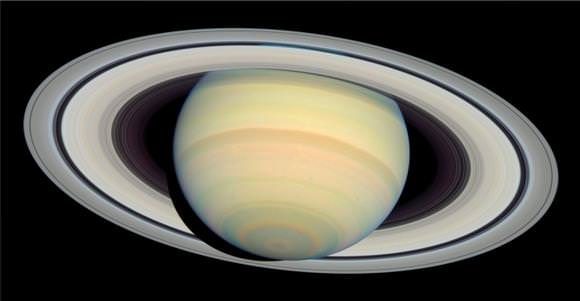[/caption]
A new estimate of Saturn’s rotation rate reveals days on the gas giant are five minutes shorter than previously believed — and that Saturn’s atmosphere has much in common with that of its planetary neighbor, Jupiter.
The new results appear today in the journal Nature.
(Image caption: Saturn as photographed by Cassini-Huygens. Credit: NASA)

For planets with solid surfaces, the spin rate can simply be determined by tracking the motion of landforms as they rotate across the surface.
Like the rocky planets, gas giant planets such as Jupiter and Saturn spin on their axes with well defined rotation periods. But, with no solid surface features to track, measuring the rotation period of a gas giant is a challenge. The approach that has worked for Jupiter, Uranus and Neptune — using the rotation of the planet’s magnetic field to infer its bulk rotation — gives results for Saturn that change with time, and implies a pattern of atmospheric winds that is very different from that seen on Jupiter.
Peter Read, of the University of Oxford in the UK, and his colleagues used atmospheric dynamics on Saturn to derive a rotation rate that is slightly faster than those inferred from magnetic measurements. When Saturn’s atmospheric winds are viewed relative to this new interior reference frame, they show a pattern of alternating eastward and westward jets similar to the pattern seen on Jupiter.
“This shifted reference frame is consistent with a pattern of alternating jets on Saturn that is more symmetrical between eastward and westward flow,”Read and his co-authors write. “This suggests that Saturn’s winds are much more like those of Jupiter than hitherto believed.”
The authors propose a new rotation rate of 10 hours and 34 minutes, as opposed to the previous estimate of 10 hours 39 minutes. The new rate also sheds light on Saturn’s interior structure, including its density and the mass of a possible rocky core. And it bears on the latitudinal gradient of temperatures below the clouds.
In a related editorial, Adam Showman of the University of Arizona in Tucson writes that there remain key differences between the atmospheres of Saturn and Jupiter: “Saturn’s winds are stronger than Jupiter’s, its banded cloud patterns and populations of hurricane-like vortices differ considerably, and its magnetic field, which is almost symmetrical about its axis — a puzzle in its own right — contrasts with Jupiter’s tilted dipole,” he notes. “These contrasts indicate that the planets are cousins rather than twins, whose intriguing mix of similarities as well as differences will keep planetary scientists engaged for years to come.”
Second image caption: An image of Saturn from NASA’s Cassini spacecraft, clearly showing the ‘geographic’ South Pole of the planet (at the center of the circle of clouds, lower left). The bulk rotation of the planet is around an axis passing through the South Pole and Saturn’s clouds (of ammonia ice) are organized into dark ‘belts’ and light ‘zones’ that are generally aligned with lines of latitude, indicating the influence of the planet’s rotation on its meteorology.
Source: Nature


I can think of another difference between the atmospheres of Jupiter and Saturn that is easy to notice: Saturn has a high deck of clouds that act to lessen the contrast and mute the color of Saturn’s lower banded clouds. Occasionally storms on Saturn may punch though this high altitude haze, or occasionally the haze layer may thin, but this is the first difference I noticed when viewing the two planets telescopically. Compare the recent Hubble images of Jupiter and compare the view with those Cassini images above.
Yes, there is a deffinate blueish haze toward the edge of the disk, indicating some light scattering.
An interesting article in “Southern Astronomical Delights” on the rotation of Saturn with a little bit of historical background might be of interest to readers of this particular article by Anne.
This is at Saturn : Part 3 “Period of Rotation”
An interesting problem.
Note: The whole rotation seems to be invariant, which might suggest the rotation changes over time.
Another new arvix article appeared on 20 July 2009 by Ravit Helled, Gerald Schubert, and John D. Anderson entitled “Jupiter and Saturn Rotation Period”
The Figure 2 in the pdf article here is most interesting, which shows the differential rates of rotation by latitude observed by Hubble – showing the variance as 200 m/s^-1.
Interesting story.
I do wonder how the International Astronomical Union (IAU) will react, and when?
Thanks for those links, Crumb 🙂 Years back, I was sending drawings of Jupiter and Saturn to ALPO (Association of Lunar and Planetary Observers). I remember having to calculate the CM (central meridian) in both Systems I and II for both planets at the time of my observations. This was a relatively simple affair and necessary for tracking longitudinal drift of various atmospheric phenomena.